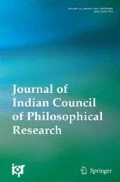Abstract
The paper aims at bringing out a valid comparison between the notion of intentionality portrayed in the phenomenology of Edmund Husserl and that of Vijňānavāda in general. One of the crucial objectives of the Husserlian phenomenology is to understand the nature of consciousness. To Husserl, Consciousness is always intentional, that is, intended or directed towards something. It constitutes the world in the sense of bestowing meaning and being to the world. The object intended by consciousness may or may not be there, but it certainly has a sense. Husserl makes a distinction between empirical and transcendental consciousness. To him, the empirical ego is momentary whilst the transcendental ego survives all reduction and presides over all epistemic acts. To explore whether the Vijňānavadins propose a similar notion of Consciousness and its intentionality would be the primary objective of the paper. On the other hand, to Vijňānavāda, the apparent external world is projected by the Absolute Consciousness, the Ālaya, not by the individual consciousness or Vijňāna. Vijňānavāda distinguishes between individual consciousness (pravritti Vijňāna) and absolute consciousness (Ālaya Vijňāna). All intentional acts are performed by the individual consciousness having the Ālaya Vijňāna as its background. The Ālaya manifests itself as subject and object as well as seven pravritti Vijňānas. They are intended and constituted by the Ālaya. It, therefore, follows that Ālaya is always intentionally correlated with the pravritti Vijňānas. Vijňānavāda appears to be a kind of constitutive phenomenology rather than idealism.
Similar content being viewed by others
Notes
Maharana (2006).
Cairns (1969).
Mohanty (2001).
Findlay (1970).
Findlay, J. N. (1970) Ibid. p. 541.
Findlay, J. N. (1970) Ibid. p. 51.
Boyce Gibson (1931).
Cairns (1967a).
Tharakan (1998).
Kuhn (1968).
Cairns (1967b).
Nanjio (1923).
Sharma (1994).
Nanjio, B. (1923) (ed.) Ibid, p. 186.
Nanjio, B. (1923) (ed.) Ibid.
Sharma, C. (2007) The Advaita Tradition in Indian philosophy. pp. 75–76; Also vide Mohanty, J. N. (2001). P, 167.
Nanjio, B. (1923) (ed.) Ibid, p. 46.
Ibid.
Ibid.
Nanjio, B. (1923) (ed.) Ibid. p. 126.
Ibid.
Levi, S. (ed) (1925) Vasubandhu Vijnaptimatratasiddhi: Vimsatika With the Author’s Own Commentary, Kārikā, 9–10, Paris.
Mohanty, J. N. (2001), Op. cit.
Ibid., p. 167.
Ibid.
Ibid. p. 168.
Ibid.
Ibid.
Levi, S. (ed) (1925) Vasubandhu Vijnaptimatratasiddhi: Trimshika with Sthiramati’s Commentary, Paris, Kārikā. 3. quoted in Sharma, Chandradhar (2007). Op.cit., p. 96.
Sharma, C. (2007). Op.cit., p. 96.
Rao (2005).
Ibid.
Maharana (2007).
Maharana, S. K. (2007). Ibid., 24 & 35.
Maharana, S. K. (2007). Ibid., 38.
Maharana (2004).
Maharana, S. K. (2007). Op. cit., p. 39.
Maharana, S. K. (2007). Ibid., 29.
Husserliana Vols., IV 105. (1975). Nijhoff: The Hague.
References
Boyce Gibson, W. R. (1931). (tr.) Ideas (p. 153). London: George Allen and Unwin Ltd.
Cairns, D. (Ed.). (1967a). Edmund Husserl, Cartesian meditations (p. 66). The Hague: Nijhoff.
Cairns, D. (1967b). Cartesian Mediations (p. 31).
Cairns, D. (1969). (tr.). Edmund Husserl: Formal and transcendental logic (Vol. 94, pp. 233–234). The Hague: Nijhoff.
Findlay, J. N. (1970). (tr.) Logical investigations, vol. II, introductory (Vol. 1, pp. 541, 551). New York: Humanities Press.
Kuhn, H. (1968). The concept of horizon. In M. Farber (Ed.), Essays in memory of Edmund Husserl (p. 110). New York: Greenwood Press Publishers.
Maharana, S. K. (2004). Samkara and Husserl: Investigations on consciousness. Ph.D. Thesis submitted to the Indian Institute of Technology, Guwahati (p. 203).
Maharana, S. K. (2006). On consciousness: Lord Buddha and Edmund Husserl. The Indian Philosophical Quarterly, XXXIII(2), 171–185.
Maharana, S. K. (2007). Phenomenology of consciousness: The Husserlian dimension. Journal of the Indian Council of Philosophical Research, 24(1), 27.
Mohanty, J. N. (2001). Explorations in philosophy (Vol. 1, p. 166). New Delhi: Oxford University Press.
Nanjio, B. (Ed.). (1923). Lankavatarasutra (pp. 158–186). Kyoto: Otani University Library.
Rao, K. R. (2005). Body, mind and spirit (p. 250).
Sharma, C. (1994). A critical survey of Indian philosophy (p. 110). Delhi: Motital Banarsidass.
Tharakan, K. (1998). Husserl’s notion of objectivity. The Indian Philosophical Quarterly, XXV(2), 216.
Author information
Authors and Affiliations
Corresponding author
Additional information
Publisher's Note
Springer Nature remains neutral with regard to jurisdictional claims in published maps and institutional affiliations.
Rights and permissions
About this article
Cite this article
Maharana, S.K. Notion of Intentionality in Vijňānavāda. J. Indian Counc. Philos. Res. 37, 291–302 (2020). https://doi.org/10.1007/s40961-020-00218-2
Received:
Accepted:
Published:
Issue Date:
DOI: https://doi.org/10.1007/s40961-020-00218-2



